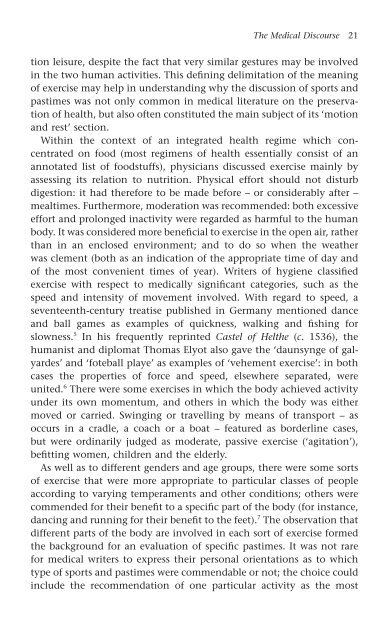Recreation in the Renaissance
Recreation in the Renaissance
Recreation in the Renaissance
- No tags were found...
You also want an ePaper? Increase the reach of your titles
YUMPU automatically turns print PDFs into web optimized ePapers that Google loves.
The Medical Discourse 21<br />
tion leisure, despite <strong>the</strong> fact that very similar gestures may be <strong>in</strong>volved<br />
<strong>in</strong> <strong>the</strong> two human activities. This def<strong>in</strong><strong>in</strong>g delimitation of <strong>the</strong> mean<strong>in</strong>g<br />
of exercise may help <strong>in</strong> understand<strong>in</strong>g why <strong>the</strong> discussion of sports and<br />
pastimes was not only common <strong>in</strong> medical literature on <strong>the</strong> preservation<br />
of health, but also often constituted <strong>the</strong> ma<strong>in</strong> subject of its ‘motion<br />
and rest’ section.<br />
With<strong>in</strong> <strong>the</strong> context of an <strong>in</strong>tegrated health regime which concentrated<br />
on food (most regimens of health essentially consist of an<br />
annotated list of foodstuffs), physicians discussed exercise ma<strong>in</strong>ly by<br />
assess<strong>in</strong>g its relation to nutrition. Physical effort should not disturb<br />
digestion: it had <strong>the</strong>refore to be made before – or considerably after –<br />
mealtimes. Fur<strong>the</strong>rmore, moderation was recommended: both excessive<br />
effort and prolonged <strong>in</strong>activity were regarded as harmful to <strong>the</strong> human<br />
body. It was considered more beneficial to exercise <strong>in</strong> <strong>the</strong> open air, ra<strong>the</strong>r<br />
than <strong>in</strong> an enclosed environment; and to do so when <strong>the</strong> wea<strong>the</strong>r<br />
was clement (both as an <strong>in</strong>dication of <strong>the</strong> appropriate time of day and<br />
of <strong>the</strong> most convenient times of year). Writers of hygiene classified<br />
exercise with respect to medically significant categories, such as <strong>the</strong><br />
speed and <strong>in</strong>tensity of movement <strong>in</strong>volved. With regard to speed, a<br />
seventeenth-century treatise published <strong>in</strong> Germany mentioned dance<br />
and ball games as examples of quickness, walk<strong>in</strong>g and fish<strong>in</strong>g for<br />
slowness. 5 In his frequently repr<strong>in</strong>ted Castel of Hel<strong>the</strong> (c. 1536), <strong>the</strong><br />
humanist and diplomat Thomas Elyot also gave <strong>the</strong> ‘daunsynge of galyardes’<br />
and ‘foteball playe’ as examples of ‘vehement exercise’: <strong>in</strong> both<br />
cases <strong>the</strong> properties of force and speed, elsewhere separated, were<br />
united. 6 There were some exercises <strong>in</strong> which <strong>the</strong> body achieved activity<br />
under its own momentum, and o<strong>the</strong>rs <strong>in</strong> which <strong>the</strong> body was ei<strong>the</strong>r<br />
moved or carried. Sw<strong>in</strong>g<strong>in</strong>g or travell<strong>in</strong>g by means of transport – as<br />
occurs <strong>in</strong> a cradle, a coach or a boat – featured as borderl<strong>in</strong>e cases,<br />
but were ord<strong>in</strong>arily judged as moderate, passive exercise (‘agitation’),<br />
befitt<strong>in</strong>g women, children and <strong>the</strong> elderly.<br />
As well as to different genders and age groups, <strong>the</strong>re were some sorts<br />
of exercise that were more appropriate to particular classes of people<br />
accord<strong>in</strong>g to vary<strong>in</strong>g temperaments and o<strong>the</strong>r conditions; o<strong>the</strong>rs were<br />
commended for <strong>the</strong>ir benefit to a specific part of <strong>the</strong> body (for <strong>in</strong>stance,<br />
danc<strong>in</strong>g and runn<strong>in</strong>g for <strong>the</strong>ir benefit to <strong>the</strong> feet). 7 The observation that<br />
different parts of <strong>the</strong> body are <strong>in</strong>volved <strong>in</strong> each sort of exercise formed<br />
<strong>the</strong> background for an evaluation of specific pastimes. It was not rare<br />
for medical writers to express <strong>the</strong>ir personal orientations as to which<br />
type of sports and pastimes were commendable or not; <strong>the</strong> choice could<br />
<strong>in</strong>clude <strong>the</strong> recommendation of one particular activity as <strong>the</strong> most










